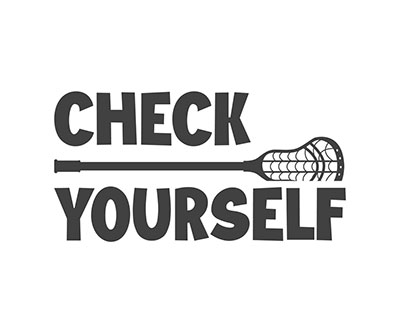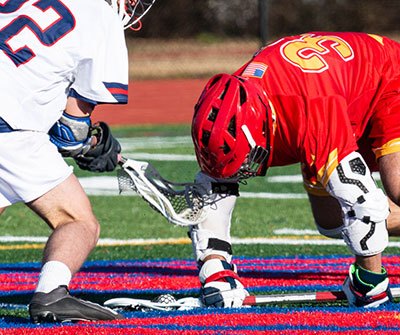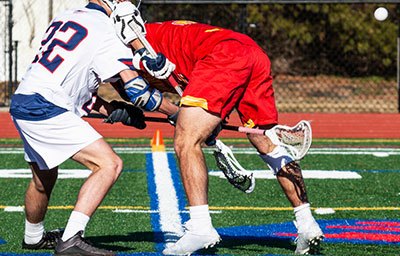Lacrosse type of check is an essential skill for lacrosse players to possess. It requires using a stick and physical contact with an opposing player to win possession of the ball, making it an excellent way for any player to gain an advantage over their opponents both defensively and offensively.
Knowing the proper technique and understanding the different types of checks can help give players the edge they need to stay ahead of their opponents on the field.
In this article, we will explore the basics of lacrosse-type checking and how to become a pro at different types of checks.
More...
Take Away Key Points:
What is checking in lacrosse?

Lacrosse-type checking is an essential skill for all lacrosse players to master. It involves using a stick and physical contact with an opposing player to gain possession of the ball carrier.
Lacrosse-type checking is a technique often used in defensive situations. Still, it can also be used offensively when trying to win a ground ball or create space for oneself or another player.
This checking requires two hands; one should grip the stick at the top near the net, while the other should grip near the bottom of the shaft.
The goal of lacrosse-type checking is to control an opponent's body while attempting to steal possession of the ball, but without causing injury or receiving a slashing penalty.
The basic checking rules
When introducing stick checking, coaches should ensure players understand the basics first. Stick checking is when a defending player uses his or her stick to lift or poke-check another player's stick to dislodge the ball. Players must remember that they cannot check an opponent above the shoulders.
Players on 7th and 8th-grade teams are allowed to use body checks, but they must still follow specific guidelines. For example, in lacrosse, a check cannot take place off-ball unless both players are within five yards of a loose ball.
A defender must also be careful not to shove an on-ball attacker from behind, though a trail check and wrap check are permissible. When contacting an opposing player's shaft, only the butt end and crosse may be checked—not between the hands.
Types of check
In NFHS and NCAA lacrosse, the body check of an opponent in possession of the ball or within 5 yards of a loose ball—from the front or side—is legal as long as it meets these criteria.
It's important to note that any contact with an opponent's head or neck area is illegal and will result in a non-releasable penalty. Additionally, any contact deemed excessive by officials is illegal and will result in a penalty.
Here are the basic legal types of check in lacrosse:
- Body checking
- Lift checks
- Poke checks
- Wrap check
- Stick check
- Trail check
1. Body checking
Legal body check is an integral part of the game of lacrosse. It involves using your body to make contact with an opponent in order to gain possession of the ball and knock the ball loose.
A body check must be done below the shoulders and above the waist, and both hands of the player must be on their stick at all times. Helmet-to-helmet and helmet-to-body checks contact are illegal, as is slashing or spearing an opponent.
Stick checks and hand checks are legal forms of body checking, and it is crucial to understand how to do them properly to avoid penalties or injuries.
2. Lift check

A legal lift check is a move used in a position where defensive players slow down an offensive player/ ball carrier who has possession of the ball. It involves using a stick or body part to raise the opponent's stick off the ground and away from their body while maintaining control of the ball. The defender must be careful not to make contact with the head or neck of the offensive player when performing this move.
The rules for legal lift checks vary by league and age group. For example, in some leagues, such as high school and college lacrosse, only one hand may be used for a legal lift check, while in others, both hands may be used.
Additionally, some leagues require that defenders keep their sticks below shoulder level when performing a legal lift check. Therefore, it's important to familiarize yourself with your league's specific rules before attempting any lift check during a game.
3. Poke check
Legal poke check is a defensive move in lacrosse where the defender uses their stick to poke at an opponent's hands in order to disrupt them and make them drop the ball. The defender must ensure that their stick is below shoulder level when performing this poke check, as contact must only be made with the stick and not any other part of the body. The poke check can also be used to disrupt players who are attempting a face or split dodge.
The most important thing for defenders to remember when performing a legal poke check is that it should never be done aggressively or with excessive force. Doing so could result in a penalty or personal foul, such as a slashing call, which would put the team at a disadvantage.
4. Wrap check
Legal wrap check is a defensive move in lacrosse where the defender wraps their stick around, or encircles, an opponent's body or stick in order to disrupt them and make them drop the ball. This move must be done carefully, as excessive force could result in a penalty or personal foul such as cross-checking. Players must also ensure their stick does not exceed shoulder level when wrapping the opponent.
When using this move, defenders should keep in mind that there are only certain situations where it is allowed. For example, it is illegal to wrap someone's body if they are the ball carrier or if they have just released their shot and the ball has yet to hit another player or the ground.
5. Stick check
Stick checks or cross-checks are an important part of the game of lacrosse. A legal stick check is done without excessive contact and is within the game's rules. Therefore, it's essential to understand the different types of stick checks and what constitutes an illegal check.
The most common type of stick check/ cross check is the Ding Dong Check, which strips the ball from an opponent/ ball carrier. Other types include Ice Pick Checks, Kayak Checks, Over Head Checks, and Rusty Gate Checks. All these cross-check types involve contact with the opponent's stick and gloves only - no contact with their head or body is allowed. Or when a defender pushes the opponent with the butt end of the stick to gain possession of the ball.
6. Trail check
A lacrosse trail check, often called a tomahawk check, is usually a last-ditch effort used when a player has been burned by their opponent. This check is typically employed when an attacking player has dodged past a defender and the defender is "trailing" behind them.
To perform a proper and legal trail check, the player must make contact with their opponent's stick without contacting any other body parts. For example, this means that a defender can't hit an attacker's helmet or shoulder pads but rather should focus on the shaft of the stick only.
If done within the rules, a proper trail check can be an effective defensive strategy that successfully throws off attackers and allows defenders to regain possession of the ball.
FAQs
What is a check in lacrosse?
A check in lacrosse is the act of using a stick to make contact with an opponent's stick in order to defend against or disrupt their offensive player's play.
Check-ins can be either legal or illegal checks, depending on the type of lacrosse check being used.

Can you hip check in lacrosse?
No, hip-checking is not allowed in lacrosse. According to the sport's rules, contact between players must be made with the stick and not with any part of the body, including the hands.
Any lacrosse check involving physical contact, such as pushing or tripping an opponent, is considered illegal.
Are one-handed checks allowed in lacrosse?
One-handed checks are allowed in lacrosse but must be done with care and caution. These checks require the player to maintain control of the stick while reaching across and making contact with their opponent's stick. This type of check is often used to slow the attack and can potentially be dangerous if not done correctly.
Are cross checks allowed in lacrosse?
Yes, cross-checks are allowed in lacrosse.
Cross-checking is a legal stick lacrosse check used to disrupt passing lanes and slow down an attack. The check must be done with proper form, with both hands on the stick, and the contact must be made with the shaft of the stick and not the blade.
It is important to note that excessive force when making a cross-check can result in penalties or ejection from the game.
Final Words
In conclusion, stick checks are an essential part of lacrosse. These checks can slow the attack and create opportunities but must be done with caution.
It is important to understand and utilize what lacrosse type of check is legal and which ones are not to avoid penalties or injuries.
